| Listing 1 - 10 of 18 | << page >> |
Sort by
|
Book
ISBN: 0323951201 032395121X 9780323951210 9780323951203 Year: 2022 Publisher: London, England ; San Diego, California ; Cambridge, Massachusetts : Academic press,
Abstract | Keywords | Export | Availability | Bookmark
 Loading...
Loading...Choose an application
- Reference Manager
- EndNote
- RefWorks (Direct export to RefWorks)
Biochemistry of Drug Metabolizing Enzymes: Trends and Challenges is a complete and well-integrated reference on their mechanisms of action, their role in diseases, agents responsible for their deactivation, and their malfunction. Chapters explain the biochemistry of DMEs, including biochemical activation, functions, computational approaches, different contaminants on the action and function of DMEs, and describe the importance of DMEs in the drug development process. Conditions covered include metabolic diseases, cardiovascular diseases, neurological diseases, physiological diseases, xenobiotics and inflammatory responses, and their contribution in the malfunctioning of drug metabolizing enzymes.
Enzymes --- Biotransformation (Metabolism) --- Biotechnology. --- Activation, Metabolic --- Bioactivation (Metabolism) --- Biodegradation (Metabolism) --- Metabolic activation --- Metabolism --- Pharmacology --- Enzymology. --- Drugs --- Biotransformation --- Pharmaceutical Preparations --- Metabolism. --- metabolism
Periodical
ISSN: 10292446 10242422 Publisher: Basel
Abstract | Keywords | Export | Availability | Bookmark
 Loading...
Loading...Choose an application
- Reference Manager
- EndNote
- RefWorks (Direct export to RefWorks)
Enzymes --- Biotransformation (Metabolism) --- Biotechnology --- Biotransformation --- Catalysis --- Industrial applications --- Biotechnologies --- Biocatalysts --- Catalyses --- Activation, Metabolic --- Bioactivation (Metabolism) --- Biodegradation (Metabolism) --- Metabolic activation --- Ferments --- Soluble ferments --- Molecular Mechanisms of Pharmacological Action --- Metabolism --- Pharmacology --- Catalysts --- Proteins --- Enzymology --- Biocatalyst --- Enzyme --- Catalysis. --- Enzymes. --- Biotechnology. --- Biotransformation. --- Biology
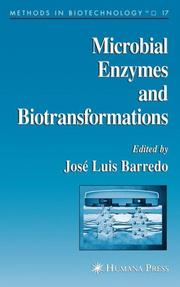
ISBN: 1588292533 9786610359660 1280359668 1592598463 Year: 2005 Publisher: Totowa, NJ : Humana Press : Imprint: Humana,
Abstract | Keywords | Export | Availability | Bookmark
 Loading...
Loading...Choose an application
- Reference Manager
- EndNote
- RefWorks (Direct export to RefWorks)
The application of recombinant DNA technology to industrial fermentation and the production of enzymes over the last 20 years has produced a host of useful chemical and biochemical substances. In Microbial Enzymes and Biotransformations, leading experts in enzyme manipulation describe in detail their cutting-edge techniques for the screening, evolution, production, immobilization, and application of enzymes. These readily reproducible methods can be used to improve enzyme function by directed evolution, to covalently immobilize enzymes, to microencapsulate enzymes and cells, and to manufacture enzymes for human health, nutrition, and environmental protection. Two overview chapters consider microorganisms as a source of metabolic and enzymatic diversity, and enzymes in the fast-moving field of enzyme biosensors. The protocols follow the successful Methods in Biotechnology™ series format, each offering step-by-step laboratory instructions, an introduction outlining the principle behind the technique, lists of the necessary equipment and reagents, and tips on troubleshooting and avoiding known pitfalls. A companion volume, Microbial Processes and Products, provides laboratory procedures for a wide range of processes and products mediated by microorganisms. Comprehensive and highly practical, Microbial Enzymes and Biotransformations offers laboratory and industrial scientists a wealth of proven enzymatic protocols that show clearly how to go from laboratory results to successful industrial applications.
Microbial enzymes --- Microbial biotechnology --- Biotransformation (Metabolism) --- Biotechnology --- Biotransformation (Metabolism) -- Laboratory manuals. --- Microbial biotechnology -- Laboratory manuals. --- Microbial enzymes -- Biotechnology -- Laboratory manuals. --- Biotransformation --- Activation, Metabolic --- Metabolic activation --- Microorganisms --- Industrial microbiology --- Biotechnological microorganisms --- Bioactivation (Metabolism) --- Biodegradation (Metabolism) --- Metabolism --- Pharmacology --- Microbiology. --- Microbial biology --- Biology
Book
ISBN: 128096054X 9786610960545 2759801144 1423744748 9781423744740 Year: 2005 Publisher: Les Ulis, France : EDP Sciences,
Abstract | Keywords | Export | Availability | Bookmark
 Loading...
Loading...Choose an application
- Reference Manager
- EndNote
- RefWorks (Direct export to RefWorks)
This work which is abundantly illustrated expounds the major role of bacteria in the protection of the environment and in the biochemical mechanisms of the biodegradations of polluting substances. Each reader will find this book useful as a tool. One can use it according to one's objectives by finding relevant information in the remarkable glossary and the long bibliography that is suggested.
Biotransformation (Metabolism) --- Biodegradation. --- Biocorrosion --- Biodecay --- Biodecomposition --- Biodeterioration --- Biological corrosion --- Biological decay --- Biological decomposition --- Biological degradation --- Decay, Biological --- Decomposition (Biology) --- Degradation, Biological --- Activation, Metabolic --- Bioactivation (Metabolism) --- Biodegradation (Metabolism) --- Metabolic activation --- Biochemistry --- Decomposition (Chemistry) --- Microbiology --- Metabolism --- Pharmacology
Book
ISBN: 0444819770 9786611058180 1281058181 0080544924 9780444819772 9780080544922 Year: 1995 Publisher: Amsterdam ; New York : Elsevier,
Abstract | Keywords | Export | Availability | Bookmark
 Loading...
Loading...Choose an application
- Reference Manager
- EndNote
- RefWorks (Direct export to RefWorks)
A comprehensive and consolidated account of how microorganisms can play a significant role in degrading and detoxifying toxic, carcinogenic, mutagenic, and teratogenic compounds is detailed in this book. Moreover, the volume deals with all aspects of microbial degradation, ranging from screening methods for the degradative microorganisms, processes of degradation, strain improvement for enhanced biodegradation, and elimination of undesirable compounds to improving health and environmental protection strategies. The book will provide an opportunity for scientists in the areas of microbiology,
Microbial metabolism --- Biotransformation (Metabolism) --- Xenobiotics --- Metabolic detoxication --- Biodegradation --- Xenobiotics - Biodegradation. --- Microbial metabolism. --- Foreign chemical compounds --- Foreign compounds --- Xenobiotic compounds --- Biochemistry --- Chemicals --- Activation, Metabolic --- Bioactivation (Metabolism) --- Biodegradation (Metabolism) --- Metabolic activation --- Metabolism --- Pharmacology --- Bacterial metabolism --- Metabolism, Bacterial --- Microorganisms --- Biodegradation. --- Metabolic detoxification. --- Physiology
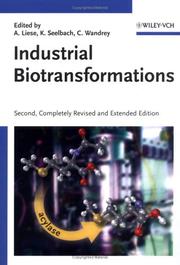
ISBN: 9783527608188 9783527310012 128072336X 3527608184 3527607900 Year: 2006 Publisher: Weinheim Wiley-VCH
Abstract | Keywords | Export | Availability | Bookmark
 Loading...
Loading...Choose an application
- Reference Manager
- EndNote
- RefWorks (Direct export to RefWorks)
The completely revised second edition of this user-friendly and application-oriented overview of one-step biotransformations of industrial importance.Based on extensive literature and patent research, this book is unique in arranging each process in a systematic way to allow for easy comparison. All the chapters have been rewritten, with all the processes updated and more than 30 new processes added. Each set of data is accompanied by key literature citations, supported by flow sheets where available, reduced to their significant elements. In addition, an extensive index classified by substrates, products, enzymes, and companies provides direct access to each process, organized according to enzyme class. Biotechnologists, biochemists, microbiologists, process engineers and those working in the chemical and biotechnological industries will find here all the significant parameters characterizing both the biotransformation and the process.
Biotransformation (Metabolism) --- Biochemical engineering --- Bio-process engineering --- Bioprocess engineering --- Biochemistry --- Biotechnology --- Chemical engineering --- Activation, Metabolic --- Bioactivation (Metabolism) --- Biodegradation (Metabolism) --- Metabolic activation --- Metabolism --- Pharmacology --- E-books --- General biochemistry --- biochemie --- biotechnologie --- enzymen
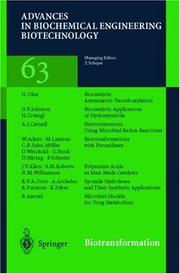
ISSN: 07246145 ISBN: 3540644962 9783540644965 3540697918 Year: 1999 Volume: 63 Publisher: Berlin Springer
Abstract | Keywords | Export | Availability | Bookmark
 Loading...
Loading...Choose an application
- Reference Manager
- EndNote
- RefWorks (Direct export to RefWorks)
The use of enzymes – employed either as isolated enzymes, crude protein extracts or whole cells – for the transformation of non-natural organic c- pounds is not an invention of the twentieth century: they have been used for more than one hundred years. However,the object of most of the early research was totally different from that of the present day. Whereas the elucidation of biochemical pathways and enzyme mechanisms was the main driving force for the early studies,in contrast it was mainly during the 1980s that the enormous potential of applying natural catalysts to transform non-natural organic c- pounds was recognized. This trend was particularly well enhanced by the recommendation of the FDA-guidelines (1992) with respect to the use of chiral bioactive agents in enantiopure form. During the last two decades, it has been shown that the substrate tolerance of numerous biocatalysts is often much wider than previously believed. Of course,there are many enzymes which are very strictly bound to their natural substrate(s). They play an important role in metabolism and they are gener- ly not applicable for biotransformations. On the other hand, an impressive number of biocatalysts have been shown to possess a wide substrate tolerance by keeping their exquisite catalytic properties with respect to chemo-, reg- and, most important, enantio-selectivity. This made them into the key tools for biotransformations.
Activation [Metabolic ] --- Bioactivation (Metabolism) --- Biodegradation (Metabolism) --- Biotransformatie (Metabolisme) --- Biotransformation (Metabolism) --- Biotransformation (Metabolisme) --- Metrabolic activation --- Animal Physiology --- Biosynthèse --- Chemistry --- Biotechnology --- Chemistry, Organic --- Chemical engineering --- Enzymes --- Organic compounds --- Biotechnology. --- Synthesis. --- Organic chemistry. --- Biochemistry. --- Organic Chemistry. --- Biochemistry, general. --- Biological chemistry --- Chemical composition of organisms --- Organisms --- Physiological chemistry --- Biology --- Medical sciences --- Genetic engineering --- Organic chemistry --- Composition --- Enzymes - Biotechnology. --- Organic compounds - Synthesis. --- BIOCHEMICAL MOLECULES --- ENZYMES --- CATALYSIS --- REACTIONS
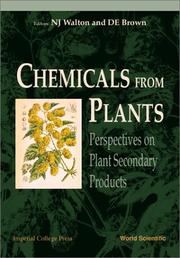
ISBN: 9812817271 9789812817273 9810227736 9789810227739 Year: 1999 Publisher: London Singapore River Edge, N.J. Imperial College Press Distributed by World Scientific
Abstract | Keywords | Export | Availability | Bookmark
 Loading...
Loading...Choose an application
- Reference Manager
- EndNote
- RefWorks (Direct export to RefWorks)
This book is principally concerned with the relatively complex small molecules produced by plants, which are important as drugs, fine chemicals, fragrances, flavours and biologically-active dietary constituents. In a wide-ranging series of thematic essays, it covers key aspects of their role in plant ecology, their metabolism in the plant, their discovery, characterisation and use and their significance in the diet. Biotechnology, including prospects for the genetic engineering of metabolic pathways, for biotransformations and also for the production of biologically-active proteins, is the foc
Plant products. --- Plant metabolites. --- Botanical chemistry. --- Metabolism, Secondary. --- Plant products --- Biotransformation (Metabolism) --- Activation, Metabolic --- Bioactivation (Metabolism) --- Biodegradation (Metabolism) --- Metabolic activation --- Metabolism --- Pharmacology --- Products, Plant --- Biological products --- Crops --- Farm produce --- Secondary metabolism --- Phytochemistry --- Plant biochemistry --- Plant chemistry --- Biochemistry --- Botany --- Phytochemicals --- Plant biochemical genetics --- Metabolites --- Analysis.
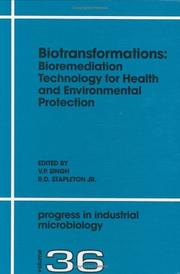
ISBN: 9780444509970 0444509976 9780080528205 0080528201 1281186767 9781281186768 9786611186760 661118676X Year: 2002 Publisher: Amsterdam New York Elsevier Science Ltd.
Abstract | Keywords | Export | Availability | Bookmark
 Loading...
Loading...Choose an application
- Reference Manager
- EndNote
- RefWorks (Direct export to RefWorks)
This volume provides a clear understanding of how microbes, following their degradative processes, contribute maximally to the benefit of mankind through biotransformations of waste materials as well as a wide variety of health-risk compounds. The book contains twenty four chapters contributed by leading scientists from different parts of the world, covering various aspects of bioremediation of xenobiotics such as toxic, carcinogenic, teratogenic, and mutagenic compounds, which include halogenated aromatics, derivatives of heavy metals, microbial toxins, tannins, dyes, sulfur compounds o
Biodegradation. --- Biotransformation (Metabolism) --- Metabolic detoxification. --- Bioremediation. --- Biodegradation --- Pollution --- Environmental biotechnology --- Metabolic conjugation --- Chemicals --- Detoxication, Metabolic --- Detoxification, Metabolic --- Metabolic detoxication --- Metabolism --- Pharmacology --- Activation, Metabolic --- Bioactivation (Metabolism) --- Biodegradation (Metabolism) --- Metabolic activation --- Biochemistry --- Decomposition (Chemistry) --- Microbiology --- Biocorrosion --- Biodecay --- Biodecomposition --- Biodeterioration --- Biological corrosion --- Biological decay --- Biological decomposition --- Biological degradation --- Decay, Biological --- Decomposition (Biology) --- Degradation, Biological --- Metabolic detoxification
Book
ISBN: 9780387773001 0387772995 9780387772998 9786612291821 1282291823 0387773002 Year: 2008 Publisher: New York : Arlington, VA : Springer ; AAPS Press,
Abstract | Keywords | Export | Availability | Bookmark
 Loading...
Loading...Choose an application
- Reference Manager
- EndNote
- RefWorks (Direct export to RefWorks)
I have always been interested in chemistry and biology. My undergraduate, graduate, and postdoctoral trainings in pharmacy, medicinal chemistry and pharmacology, respectively, have strengthened this interest and led me to realize that significant advances in medicine have frequently been realized because of research at the chem- try–biology interface. I am hoping that this comprehensive volume on recent advances in bioactivation research will stimulate pharmacologists, medicinal chemists, phar- ceutical scientists, and graduate students in these fields and related areas to consider and use bioactivation research when they explore and chart new frontiers in drug design and drug development and when they consider ways to reduce the side effects of existing drugs by making prodrugs. As for the toxicologists and environmental health scientists, I hope this volume will help them generate the knowledge needed to understand better mechanisms of toxicity to improve human risk assessments and intervention methods after occupational or environmental exposure to various hazardous chemicals. Adnan A. Elfarra, Ph. D. vii Part I General Concepts and Basic Mechanisms 1 Metabolic Concerns in Drug Design Jeffrey P. Jones Department of Chemistry, Washington State University, Pullman, WA 99164, USA e-mail: jpj@wsu. edu Keywords: Cytochrome P450 Aldehyde Oxidase Drug–Drug Interactions Mechanism-based Virtual Screening ADMET Regioselectivity 1. 1. Introduction Due to recent technological innovations, such as genomics, combinatorial chemistry, and high-throughput screening, the identification of disease targets and of compounds that are active against these targets (‘‘leads’’) can now be carried out efficiently.
Biomedicine. --- Pharmacology/Toxicology. --- Immunology. --- Medicine. --- Toxicology. --- Médecine --- Immunologie --- Toxicologie --- Biotransformation (Metabolism). --- Biotransformation. --- Drug activation. --- Biotransformation (Metabolism) --- Drug activation --- Pharmacological Processes --- Metabolism --- Metabolic Phenomena --- Pharmacological Phenomena --- Physiological Processes --- Physiological Phenomena --- Phenomena and Processes --- Biotransformation --- Human Anatomy & Physiology --- Health & Biological Sciences --- Animal Biochemistry --- Activation, Metabolic --- Bioactivation (Metabolism) --- Biodegradation (Metabolism) --- Metabolic activation --- Activation of drugs --- Drugs --- Activation --- Pharmacology. --- Pharmacology --- Immunobiology --- Life sciences --- Serology --- Chemicals --- Medicine --- Poisoning --- Poisons --- Toxicology --- Drug effects --- Medical pharmacology --- Medical sciences --- Chemotherapy --- Pharmacy --- Physiological effect
| Listing 1 - 10 of 18 | << page >> |
Sort by
|

 Search
Search Feedback
Feedback About UniCat
About UniCat  Help
Help News
News